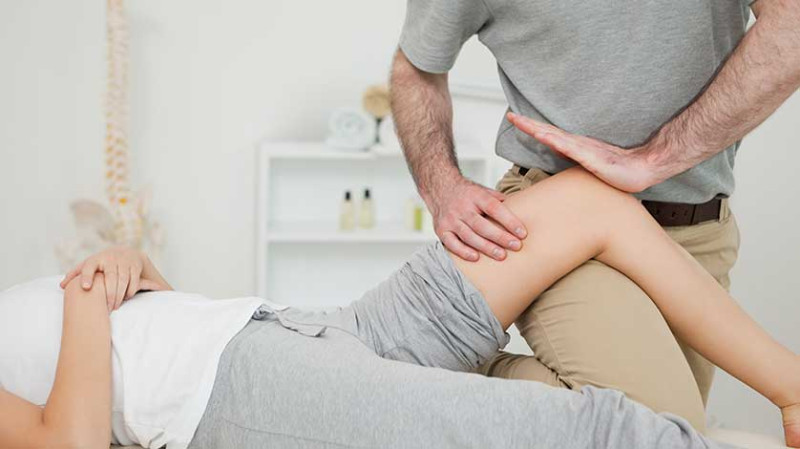
If you've ever experienced tightness, discomfort, or even mild pain in your lower back - whether it's after a long day working on-site, a weekend of redecorating, or sitting at a desk - you're not alone. For many DIY enthusiasts, young professionals, architects, and tradespeople across the UK, lower back issues are an all-too-common complaint. While some may turn to massages or over-the-counter painkillers, an effective and increasingly popular approach is osteopathic manipulation.
A particularly compelling physical response during treatment - often heard and felt is the "massive back crack". While the sound may be startling, it usually signals a successful adjustment using osteopathic techniques. In this article, we'll dive into the mechanics and benefits of osteopathic manipulation for the lower back, explain the science behind the infamous crack, and explore how this technique can help you stay mobile and pain-free, whether you're tiling a bathroom, framing a window, or mapping out interior spaces.
What Is Osteopathic Manipulation?
Osteopathic Manipulative Treatment (OMT) is a hands-on technique used by osteopaths to diagnose, treat, and prevent conditions related to the musculoskeletal system. It involves moving muscles and joints using stretching, resistance, and gentle pressure. When applied to the lower back, the goal of OMT is usually to relieve stiffness, improve mobility, and correct structural misalignments.
Unlike chiropractic approaches, which often focus on high-velocity thrusts, osteopathic manipulation tends to be more holistic and tailored to the patient's entire physical condition. In the UK, a registered osteopath completes years of rigorous training to understand how body structure relates to function, enabling them to treat the body as a single connected system.
Lower back osteopathic adjustments are particularly common among physical workers and those exposed to repetitive motion like bending, lifting, or prolonged sitting - think of interior decorators climbing ladders, electricians under floorboards, or young professionals spending hours at a home-office desk.
The Science Behind the Back Crack
The iconic "pop" or "crack" that sometimes accompanies an osteopathic adjustment is medically known as joint cavitation. This sound occurs when a gas bubble is rapidly released from the synovial fluid in the joint as pressure suddenly changes. It's similar to opening a fizzy drink - except it's your joints doing the fizzing!
The sound itself is harmless. Despite old myths, frequent "cracking" doesn't lead to arthritis or joint damage. It's often a sign that joint pressure has been relieved and range of motion increased. In most cases, the cracking noise isn't even necessary for the adjustment to be effective - some feel immense relief without any audible pop at all.
While the sound is dramatic, the benefits are more than noise: reduced tension in nearby muscles, more fluid joint movement, better posture, and in some cases, immediate pain relief. These outcomes are especially valuable if you've been straining during a loft conversion or hunching over detailed blueprints in your studio.
Lower Back Pain: A UK-Wide Epidemic
Over 80% of adults in the UK will experience lower back pain at some point in their lives, often driven by work conditions or poor ergonomics. For tradespeople like plasterers and joiners, repetitive lifting and twisting motions can gradually misalign the spine. For creative professionals such as designers sitting at screens for hours, posture-related pain is a constant risk.
Here's a quick snapshot of the most common causes of lower back pain based on lifestyle segments:
| Audience Segment | Common Cause of Lower Back Pain |
|---|---|
| DIY Enthusiasts | Improper lifting of materials, prolonged crouching or bending |
| Young Professionals | Prolonged desk work, poor ergonomic setup at home |
| Architects & Designers | Hunched posture while working at drafting tables or laptops |
| Tradesmen | Manual labour over long hours, frequent strain on lower spine |
Regardless of the source, osteopathy offers a tailored solution that addresses not just the pain but the lifestyle contributions behind it.
What to Expect from an Osteopathic Lower Back Adjustment
Your first visit to an osteopath will typically include a full consultation where they assess your posture, joints, and overall muscular health. They'll ask about your daily routine - for example, how you lift materials, how long you sit at a desk, or what kind of footwear you use on job sites - to understand precisely how your lifestyle may be contributing to your symptoms.
During treatment, the practitioner may position you on your side or back, gently rotating your body while applying pressure to a strategic point along the spine. If the technique is successful, you might hear the signature crack as the joint releases tension. Many patients describe an instant sense of relief, improved flexibility, and clearer posture alignment.
Sessions usually last between 30-45 minutes, and some people see improvements in just one or two visits. However, since realignment is only part of the process, your osteopath may also advise postural correction techniques, stretches and strengthening movements to help prolong the results of your treatment.
DIY at Home: Can You Crack Your Own Back Safely?
While self-adjustments might provide temporary relief (like the classic twist-the-torso-and-pop-the-spine move), these techniques are not as precise as those performed by professionals. Without proper knowledge of spinal anatomy and joint direction, there's a risk of over-rotating or applying pressure to the wrong area, especially in the lower back where the lumbar vertebrae are more prone to damage.
Still, there are safe alternatives like gentle mobility exercises, stretches, and foam roller use that can help manage discomfort between professional treatments. Cat-cow stretches, pelvic tilts, and child's pose are all examples of low-risk movements that support healthy spinal positioning. But if persistent pain recurs, avoid the temptation to go full DIY - go see a certified osteopath.
Is Osteopathy Right for You?
Whether you're a London-based graphic designer contending with remote work posture problems or a tradie in Leeds hauling building materials daily, osteopathy can be a transformative solution to lower back strain. It's non-invasive, drug-free, and designed to promote whole-body balance and recovery - ideal for those who want to stay active and return to the work they love without lingering discomfort.
Osteopathic manipulation isn't just for those already struggling with chronic pain. It also serves as a preventive measure to keep your spine functioning optimally and reduce injury risk down the line. Consider it a tune-up for your body - much like you'd do with your tools, van, or work boots.
If you're based in the UK and suffer from recurring lower back issues or limited range of movement, it's worth booking a consultation with a registered osteopath. Your future self (and your lower lumbar discs) will thank you.



